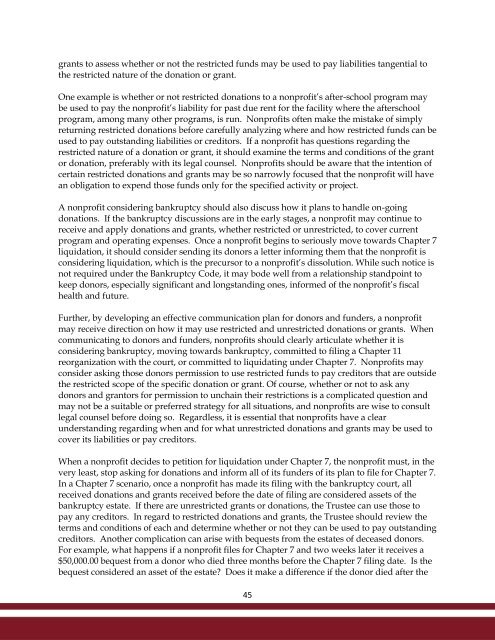Guide-for-Nonprofit-Organizations-Bankruptcy-Issues-FINAL-with-ads
Guide-for-Nonprofit-Organizations-Bankruptcy-Issues-FINAL-with-ads
Guide-for-Nonprofit-Organizations-Bankruptcy-Issues-FINAL-with-ads
- No tags were found...
Create successful ePaper yourself
Turn your PDF publications into a flip-book with our unique Google optimized e-Paper software.
grants to assess whether or not the restricted funds may be used to pay liabilities tangential tothe restricted nature of the donation or grant.One example is whether or not restricted donations to a nonprofit’s after-school program maybe used to pay the nonprofit’s liability <strong>for</strong> past due rent <strong>for</strong> the facility where the afterschoolprogram, among many other programs, is run. <strong>Nonprofit</strong>s often make the mistake of simplyreturning restricted donations be<strong>for</strong>e carefully analyzing where and how restricted funds can beused to pay outstanding liabilities or creditors. If a nonprofit has questions regarding therestricted nature of a donation or grant, it should examine the terms and conditions of the grantor donation, preferably <strong>with</strong> its legal counsel. <strong>Nonprofit</strong>s should be aware that the intention ofcertain restricted donations and grants may be so narrowly focused that the nonprofit will havean obligation to expend those funds only <strong>for</strong> the specified activity or project.A nonprofit considering bankruptcy should also discuss how it plans to handle on-goingdonations. If the bankruptcy discussions are in the early stages, a nonprofit may continue toreceive and apply donations and grants, whether restricted or unrestricted, to cover currentprogram and operating expenses. Once a nonprofit begins to seriously move towards Chapter 7liquidation, it should consider sending its donors a letter in<strong>for</strong>ming them that the nonprofit isconsidering liquidation, which is the precursor to a nonprofit’s dissolution. While such notice isnot required under the <strong>Bankruptcy</strong> Code, it may bode well from a relationship standpoint tokeep donors, especially significant and longstanding ones, in<strong>for</strong>med of the nonprofit’s fiscalhealth and future.Further, by developing an effective communication plan <strong>for</strong> donors and funders, a nonprofitmay receive direction on how it may use restricted and unrestricted donations or grants. Whencommunicating to donors and funders, nonprofits should clearly articulate whether it isconsidering bankruptcy, moving towards bankruptcy, committed to filing a Chapter 11reorganization <strong>with</strong> the court, or committed to liquidating under Chapter 7. <strong>Nonprofit</strong>s mayconsider asking those donors permission to use restricted funds to pay creditors that are outsidethe restricted scope of the specific donation or grant. Of course, whether or not to ask anydonors and grantors <strong>for</strong> permission to unchain their restrictions is a complicated question andmay not be a suitable or preferred strategy <strong>for</strong> all situations, and nonprofits are wise to consultlegal counsel be<strong>for</strong>e doing so. Regardless, it is essential that nonprofits have a clearunderstanding regarding when and <strong>for</strong> what unrestricted donations and grants may be used tocover its liabilities or pay creditors.When a nonprofit decides to petition <strong>for</strong> liquidation under Chapter 7, the nonprofit must, in thevery least, stop asking <strong>for</strong> donations and in<strong>for</strong>m all of its funders of its plan to file <strong>for</strong> Chapter 7.In a Chapter 7 scenario, once a nonprofit has made its filing <strong>with</strong> the bankruptcy court, allreceived donations and grants received be<strong>for</strong>e the date of filing are considered assets of thebankruptcy estate. If there are unrestricted grants or donations, the Trustee can use those topay any creditors. In regard to restricted donations and grants, the Trustee should review theterms and conditions of each and determine whether or not they can be used to pay outstandingcreditors. Another complication can arise <strong>with</strong> bequests from the estates of deceased donors.For example, what happens if a nonprofit files <strong>for</strong> Chapter 7 and two weeks later it receives a$50,000.00 bequest from a donor who died three months be<strong>for</strong>e the Chapter 7 filing date. Is thebequest considered an asset of the estate? Does it make a difference if the donor died after the45


